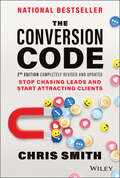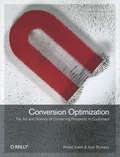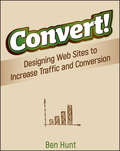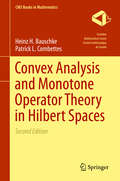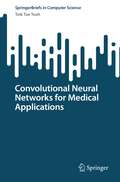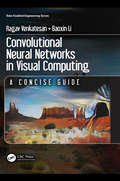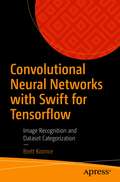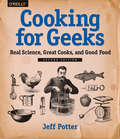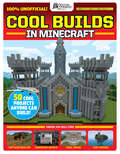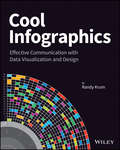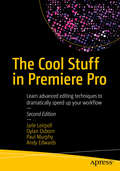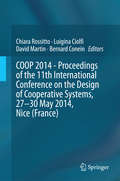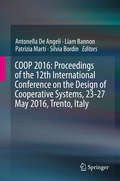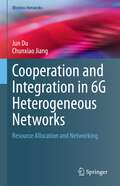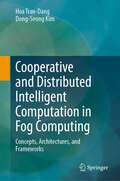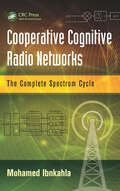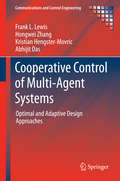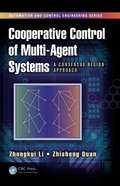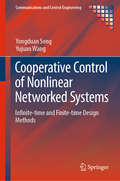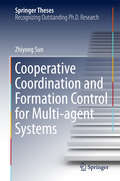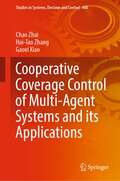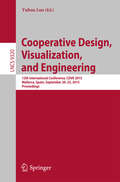- Table View
- List View
The Conversion Code: Stop Chasing Leads and Start Attracting Clients
by Chris SmithThe new edition of the bestselling book for real estate agents, loan officers, SaaS and small businesses. In this revision, The Conversion Code: A Step-by-Step Guide to Marketing and Sales that Will Grow Your Business Faster, Second Edition, digital marketing and lead conversion expert Chris Smith delivers the ultimate exploration of the marketing and advertising tactics that are successfully generating higher quality leads that are easier for salespeople to convert. Smith researches and tests the latest and most popular platforms, including TikTok, YouTube and Instagram, while also studying the most effective sales techniques, tools, and scripts. In this book, you'll learn to: Increase your lead conversion rate, reduce your cost per lead and improve your overall ROI from marketing and sales Generate an endless supply of high-quality leads from social media that are easy to convert into closed sales Stop chasing leads and start attracting clients with amazing marketing and clever ads Adapt to the consumer privacy changes that have made targeting ads and getting leads to answer the phone harder than ever Differentiate your brand in a way that positions you as the authority and gets people contacting you who are already sold An invaluable reference and easy to follow guide for real estate agents, loan officers, SaaS and small businessescompeting in the hyper-competitive online environment. The Conversion Code, Second Edition, is also a fantastic resource for sales leaders, marketing managers, business owners and anyone else with a team who is responsible for growing revenue.
Conversion-Optimierung: Über 150 Praxistipps zu datengetriebenem Marketing, Analytics & Webseitenoptimierung
by Tobias LooscheldersDieses Buch ist ein praxiserprobter Guide, mit dem Sie Ihre Marketing-Kampagnen, Landingpages und Websites systematisch optimieren können. Zugleich ist es ein perfekter Leitfaden für den Einstieg in ein datengetriebenes Marketing. Es richtet sich an Berufseinsteiger im professionellen Online-Marketing und Marketers mit einigen Jahren Erfahrung, die nun den nächsten Schritt tun wollen.Über die Conversion-Optimierung werden Online-Kampagnen und Webseiten erfolgreicher gemacht – zudem lernt man viel über seine Kund:innen. Die Grundlage dafür sind Daten. Diese bilden das Fundament für effektive Maßnahmen wie A/B-Testing, Personalisierung und letztlich mehr Umsatz. Wer die dafür notwendigen Tools, Prozesse und KPIs beherrscht, erzielt bessere Ergebnisse und schafft entscheidende Wettbewerbsvorteile für das eigene Unternehmen.Das Buch ist gespickt mit handfesten Tipps für Marketers, die konsequent Ihr Online-Marketing mit einem datengetriebenen Ansatz nach vorne bringen wollen. Konkrete Modelle und Vorgehensweisen schaffen dafür Sicherheit und Durchblick. Tobias Looschelders erklärt u.a., wie die Optimierung von Webseiten mit dem 6-stufigen RETURN-Modell funktioniert, die Priorisierung von A/B-Tests mit dem SCORE-Framework verbessert wird oder Digital-Marketing-Maßnahmen optimiert werden können.Aus dem InhaltConversion Rates optimieren und mit effizienterem Marketing Geld sparenErfolgreiche Webseitenoptimierung: Best Practices mit dem RETURN-ModellA/B-Testing: mit Experimenten Webseiten systematisch optimierenErfolgreiche Optimierung und A/B-Testing von DigitalkampagnenIndividualisierte Webseiten und personalisiertes MarketingDie Geheimnisse funktionierender Conversion-OptimierungMit Gastbeiträgen von Philipp Mantel (case study air up GmbH) und Benjamin Uhlmann (case study Reishunger GmbH)Was Sie aus den einzelnen Kapitel mitnehmen werden:Aus Kapitel 1 „Conversion-Optimierung als Motor des Online-Erfolg“Was Conversions sind und weshalb die Conversion Rate ein so wichtiger Optimierungshebel ist.Wie sich die relevantesten Ansprüche und Bedürfnisse von Web-User:innen aktuell darstellen.Warum es so wichtig ist, über die verschiedenen Nutzergruppen Ihrer Webseite nachzudenken.Welche die wichtigsten Werkzeuge der Conversion-Optimierung sind.Wie Sie gute Optimierungsideen entwickeln.Einen konkreten 10-Schritte-Plan für die Implementierung datengetriebenen Marketings in Ihrem Unternehmen.Aus Kapitel 2 „Erfolgreiche Webseitenoptimierung“Die sechs wichtigsten Kategorien der Webseitenoptimierung.Worauf Sie achten sollten um Erstbesucher:innen Ihrer Webseite in den wichtigen ersten Sekunden für sich zu gewinnenMaßnahmen zur Steigerung der Interaktion mit Ihrer Webseite.Wie Sie die Benutzerfreundlichkeit von Webseiten erhöhen und Hürden für die Nutzer:innen abbauen.Wie Sie über Ihre Webseite klar und zielführend kommunizieren und erfolgreich argumentieren.Diverse Impulse, wie Sie Ihre Internetpräsenzen vertrauensschaffender gestalten können.Aus Kapitel 3 „A/B-Testing“Was Sie alles A/B-testen können, um den Erfolg Ihrer Webseite zu verbessern.Praktische Tipps zum A/B-Testing von Webseiten und welche Stolpersteine es zu vermeiden gilt.Warum es so wichtig ist, Testlaufzeiten einzuhalten (auch wenn es schwerfällt).Mit welchem kostenfreien Tool Sie ins A/B-Testing einsteigen können.Welche Kennzahlen Sie benötigen und warum dazu keine theoretische Statistik nötig ist.Wie Sie erfolgreich Test-Hypothesen formulieren.Konkretes Handwerkzeug, um Ihre Testideen faktenbasiert priorisieren zu können.Aus Kapitel 4 „Erfolgreiche Optimierung und A/B-Test
Conversion Optimization: The Art and Science of Converting Prospects to Customers
by Khalid Saleh Ayat ShukairyHow do you turn website visitors into customers? Conversion Optimization offers practical advice on how to persuade visitors to make a buying decision -- without driving them away through data overload or tedious navigation. You'll learn how to use marketing principles, design, usability, and analytics on your site to increase your buyer-to-visitor ratio, whether you're involved with marketing or designing a large ecommerce site, or managing a modest online operation. Based on the authors' broad experience in helping businesses attract online customers, this book addresses every aspect of the process, from landing visitors to finalizing the sale. You'll learn several techniques for blending successful sales approaches with the particular needs of the people you want to attract. Are you ready to do what it takes to get a double-digit conversion rate? Explore case studies involving significant conversion rate improvements Walk through different stages of a sale and understand the value of each Understand your website visitors through persona creation Connect with potential customers and guide them toward a conversion Learn how to deal with FUDs -- customer fears, uncertainties, and doubts Examine the path that visitors take from landing page to checkout Test any change you make against your original design "The Web is unique in its ability to deliver this almost improbable win-win: You can increase revenue AND make your customers happy. Yet most websites stink. Worry not, Khalid and Ayat to the rescue! Buy this book to follow their practical advice on how to create high converting websites that your visitors love." --Avinash Kaushik, author of Web Analytics 2.0 and Web Analytics: An Hour A Day (both Sybex)
Convert!
by Ben HuntSolve your traffic troubles and turn browsers into buyersWhen web design expert Ben Hunt set out to quantify the difference between an ordinary web site and a great one, he expected to find the key in design simplicity. But when his team more than doubled the conversion rates for a wide range of sites, they identified simple yet powerful solutions involving design, copy, appropriate analysis, classic optimization techniques, and targeted testing. You'll find the fixes easy to implement, and they're all right here.Understand the essentials - your market, your proposition, and your delivery.Create a site that is seen by the right people, provides a compelling experience, and generates the desired action.Learn how to use testing to improve your site's conversion rate.Discover the holistic nature of web site optimization and why multiplicity matters.Examine dozens of simple techniques for building traffic, engaging your audience, and crafting effective calls to action.Combine creativity with analysis for the best possible results.Ben Hunt is Principal Consultant for Scratchmedia Ltd. He operates webdesignfromscratch.com, which provides tutorials and advice to over 120,000 web developers each month. Ben has been designing, coding, and producing web sites for clients worldwide for more than 15 years, and is considered a leader in the web usability industry.Forewords by Ken McCarthy, founder of the System Seminar, and Drayton Bird, Drayton Bird Associates.
Convex Analysis and Monotone Operator Theory in Hilbert Spaces (CMS Books in Mathematics)
by Heinz H. Bauschke Patrick L. CombettesThis reference text, now in its second edition, offers a modern unifying presentation of three basic areas of nonlinear analysis: convex analysis, monotone operator theory, and the fixed point theory of nonexpansive operators. Taking a unique comprehensive approach, the theory is developed from the ground up, with the rich connections and interactions between the areas as the central focus, and it is illustrated by a large number of examples. The Hilbert space setting of the material offers a wide range of applications while avoiding the technical difficulties of general Banach spaces. The authors have also drawn upon recent advances and modern tools to simplify the proofs of key results making the book more accessible to a broader range of scholars and users. Combining a strong emphasis on applications with exceptionally lucid writing and an abundance of exercises, this text is of great value to a large audience including pure and applied mathematicians as well as researchers in engineering, data science, machine learning, physics, decision sciences, economics, and inverse problems. The second edition of Convex Analysis and Monotone Operator Theory in Hilbert Spaces greatly expands on the first edition, containing over 140 pages of new material, over 270 new results, and more than 100 new exercises. It features a new chapter on proximity operators including two sections on proximity operators of matrix functions, in addition to several new sections distributed throughout the original chapters. Many existing results have been improved, and the list of references has been updated.Heinz H. Bauschke is a Full Professor of Mathematics at the Kelowna campus of the University of British Columbia, Canada.Patrick L. Combettes, IEEE Fellow, was on the faculty of the City University of New York and of Université Pierre et Marie Curie – Paris 6 before joining North Carolina State University as a Distinguished Professor of Mathematics in 2016.
Convolutional Neural Networks for Medical Applications (SpringerBriefs in Computer Science)
by Teik Toe TeohConvolutional Neural Networks for Medical Applications consists of research investigated by the author, containing state-of-the-art knowledge, authored by Dr Teoh Teik Toe, in applying Convolutional Neural Networks (CNNs) to the medical imagery domain. This book will expose researchers to various applications and techniques applied with deep learning on medical images, as well as unique techniques to enhance the performance of these networks.Through the various chapters and topics covered, this book provides knowledge about the fundamentals of deep learning to a common reader while allowing a research scholar to identify some futuristic problem areas. The topics covered include brain tumor classification, pneumonia image classification, white blood cell classification, skin cancer classification and diabetic retinopathy detection. The first chapter will begin by introducing various topics used in training CNNs to help readers with common concepts covered across the book. Each chapter begins by providing information about the disease, its implications to the affected and how the use of CNNs can help to tackle issues faced in healthcare. Readers would be exposed to various performance enhancement techniques, which have been tried and tested successfully, such as specific data augmentations and image processing techniques utilized to improve the accuracy of the models.
Convolutional Neural Networks in Visual Computing: A Concise Guide (Data-Enabled Engineering)
by Ragav Venkatesan Baoxin LiThis book covers the fundamentals in designing and deploying techniques using deep architectures. It is intended to serve as a beginner's guide to engineers or students who want to have a quick start on learning and/or building deep learning systems. This book provides a good theoretical and practical understanding and a complete toolkit of basic information and knowledge required to understand and build convolutional neural networks (CNN) from scratch. The book focuses explicitly on convolutional neural networks, filtering out other material that co-occur in many deep learning books on CNN topics.
Convolutional Neural Networks with Swift for Tensorflow: Image Recognition and Dataset Categorization
by Brett KoonceDive into and apply practical machine learning and dataset categorization techniques while learning Tensorflow and deep learning. This book uses convolutional neural networks to do image recognition all in the familiar and easy to work with Swift language. It begins with a basic machine learning overview and then ramps up to neural networks and convolutions and how they work. Using Swift and Tensorflow, you'll perform data augmentation, build and train large networks, and build networks for mobile devices. You’ll also cover cloud training and the network you build can categorize greyscale data, such as mnist, to large scale modern approaches that can categorize large datasets, such as imagenet. Convolutional Neural Networks with Swift for Tensorflow uses a simple approach that adds progressive layers of complexity until you have arrived at the current state of the art for this field. What You'll LearnCategorize and augment datasetsBuild and train large networks, including via cloud solutionsDeploy complex systems to mobile devicesWho This Book Is ForDevelopers with Swift programming experience who would like to learn convolutional neural networks by example using Swift for Tensorflow as a starting point.
Cook Over IP: Cordless Smart Kitchen Appliance Architectures and Protocols (SpringerBriefs in Applied Sciences and Technology)
by Shruthi Kashyap Vijay Rao Ranga Rao Venkatesha Prasad Toine StaringThis book focuses on enabling internet connectivity to cordless kitchen appliances. It introduces the Ki Cordless Kitchen standard, describes the possible architectures to enable internet connectivity and dives deep into addressing the networking challenges. Today many kitchen appliances are being connected to the internet to facilitate “smart cooking”. The Wireless Power Consortium is working on the Ki Cordless Kitchen standard to make wirelessly powered cordless appliances a reality. In Ki, the cordless appliances are powered by inductive power sources integrated into the kitchen countertops. The cordless appliance and the power transmitter exchange data using a time-slotted NFC channel. The book describes architectures and solutions using lightweight TCP/IP stacks to optimise and seamlessly adapt TCP to the time-slotted, low data rate NFC channel, and thereby enable a truly IoT-based cooking experience for cordless kitchens.
Cooking for Geeks
by Jeff PotterAre you the innovative type, the cook who marches to a different drummer -- used to expressing your creativity instead of just following recipes? Are you interested in the science behind what happens to food while it's cooking? Do you want to learn what makes a recipe work so you can improvise and create your own unique dish? More than just a cookbook, Cooking for Geeks applies your curiosity to discovery, inspiration, and invention in the kitchen. Why is medium-rare steak so popular? Why do we bake some things at 350° F/175° C and others at 375° F/190° C? And how quickly does a pizza cook if we overclock an oven to 1,000° F/540° C? Author and cooking geek Jeff Potter provides the answers and offers a unique take on recipes -- from the sweet (a "mean" chocolate chip cookie) to the savory (duck confit sugo). This book is an excellent and intriguing resource for anyone who wants to experiment with cooking, even if you don't consider yourself a geek. Initialize your kitchen and calibrate your tools Learn about the important reactions in cooking, such as protein denaturation, Maillard reactions, and caramelization, and how they impact the foods we cook Play with your food using hydrocolloids and sous vide cooking Gain firsthand insights from interviews with researchers, food scientists, knife experts, chefs, writers, and more, including author Harold McGee, TV personality Adam Savage, chemist Hervé This, and xkcd "My own session with the book made me feel a lot more confident in my cooking." --Monica Racic,The New Yorker "I LOVE this book. It's inspiring, invigorating, and damned fun to spend time inside the mind of 'big picture' cooking. I'm Hungry!" --Adam Savage, co-host of Discovery Channel's MythBusters "In his enchanting, funny, and informative book, Cooking for Geeks (O'Reilly), Jeff Potter tells us why things work in the kitchen and why they don't." -- Barbara Hanson, NewYork Daily News
Cooking for Geeks: Real Science, Great Cooks, and Good Food (2nd Edition)
by Jeff PotterWhy do we cook the way we do? Are you the innovative type, used to expressing your creativity instead of just following recipes? Do you want to learn to be a better cook or curious about the science behind what happens to food as it cooks?More than just a cookbook, Cooking for Geeks applies your curiosity to discovery, inspiration, and invention in the kitchen. Why do we bake some things at 350°F/175°C and others at 375°F/190°C? Why is medium-rare steak so popular? And just how quickly does a pizza cook if we overclock an oven to 1,000 F/540 C? Author and cooking geek Jeff Potter provides the answers to these questions and more, and offers his unique take on recipes -- from the sweet (a patent-violating chocolate chip cookie) to the savory (slow-cooked brisket).This book is an excellent and intriguing resource for anyone who enjoys cooking or wants to experiment in the kitchen.Discover what type of cook you are and calibrate your tools Learn about the important reactions in cooking, such as protein denaturation, Maillard reactions, and caramelization, and how they impact the foods we cook. Gain firsthand insights from interviews with researchers, food scientists, knife experts, chefs, writers, and more, including author Harold McGee, TV personality Adam Savage, and chemist Hervé.
Cool Builds in Minecraft! (GamesMaster Presents)
by Future PublishingGet building today! This book is full of cool Minecraft projects and awesome advice that will help you become a master builder in no time.Get building today! For those who want to master the most important and most challenging aspect of Minecraft, GamesMaster Presents: Cool Builds in Minecraft! is the definitive book out there that covers mining resources to crafting buildings, vehicles and even entire worlds. Perfect for players of all ages who want to improve their crafting skills, this book will take you all the way from crafting your first shelter, to putting the finishing touches to your very own mega-build masterclasses. Includes full-color images and step-by-step instructions for 50 cool Minecraft builds. 100% unofficial. Created by Future plc and GamesMaster, leaders in video game publishing.
Cool Infographics
by Randy KrumMake information memorable with creative visual design techniquesResearch shows that visual information is more quickly and easily understood, and much more likely to be remembered. This innovative book presents the design process and the best software tools for creating infographics that communicate. Including a special section on how to construct the increasingly popular infographic resume, the book offers graphic designers, marketers, and business professionals vital information on the most effective ways to present data. Explains why infographics and data visualizations work Shares the tools and techniques for creating great infographicsCovers online infographics used for marketing, including social media and search engine optimization (SEO)Shows how to market your skills with a visual, infographic resumeExplores the many internal business uses of infographics, including board meeting presentations, annual reports, consumer research statistics, marketing strategies, business plans, and visual explanations of products and services to your customersWith Cool Infographics, you'll learn to create infographics to successfully reach your target audience and tell clear stories with your data.
The Cool Stuff in Premiere Pro
by Jarle Leirpoll Dylan Osborn Paul Murphy Andy EdwardsGain in-depth knowledge of Premiere Pro, and learn how the software "thinks. " You'll acquire new skills that will help you choose the best workflow for your project, and simplify and accelerate your video editing process. Learn how you can edit a lot faster with smarter workflows that automate several steps in the editing process. You'll also see how custom settings, presets, keyboard shortcuts and templates saves hours of work. By tailoring the software to your needs you save clicks on just about every task. With many traditional jobs now being done by one person, its important to understand audio smoothing, color grading, motion graphics, and advanced editing techniques. You'll learn these skills and disciplines and see how they'll enhance your project's workflow. All the authors are professional editors and want to know exactly how to cut your film as fast as possible with top quality output. There is invaluable information in The Cool Stuff in Premiere Pro that's not available anywhere else - not even in Adobe's own manuals. What You'll Learn Edit faster, no matter what the project Understand the technical stuff, like timeline settings, render codecs, color subsampling, export settings, effect controls and monitor settings Know when to send your clips to other Adobe software, and how to treat them there. Master the Premiere Pro timeline, even stacks of timelines, and edit, trim and adjust with ease Who This Book Is For Video journalists (and everyone else) will learn how to edit faster and get home in time for dinner. Bloggers will learn how to make their online video and audio "pop". Film cutters will learn how to organize, rough cut and fine tune huge amounts of material effectively and how to output for digital cinema. Experienced video editors will learn how to deal with multi-track audio and to work faster in every step of the edit. Marketing people who edit video for social media and web pages will learn simpler ways to make a faster cut. Teachers in media studies will understand the logic in Premiere Pro, and be better prepared for teaching video editing.
COOP 2014 - Proceedings of the 11th International Conference on the Design of Cooperative Systems, 27-30 May 2014, Nice (France)
by David Martin Luigina Ciolfi Chiara Rossitto Bernard ConeinThis volume presents the proceedings of the 11th International Conference on the Design of Cooperative Systems (COOP 2014). The conference is a venue for multidisciplinary research contributing to the design, assessment and analysis of cooperative systems and their integration in organizations, public venues, and everyday life. COOP emerged from the European tradition of Computer Supported Cooperative Work (CSCW) and Cognitive Ergonomics as practiced in France These proceedings are a collection of 28 papers reflecting the variety of research activities in the field, as well as an increasing interest in investigating the use and design of ICT in all aspects of everyday life and society, and not merely in the workplace. The papers represent a variety of research topics, from healthcare to sustainable mobility to disaster response, in settings from all over the world. For the first time, the proceedings include papers presented in an Early-Career Researchers Track which was organized in order to give young researchers the opportunity to discuss their work with an international community. This collection of papers provides a picture of new developments and classic topics of research around cooperative systems, based on the principle that a deep knowledge of cooperative practices is a key to understanding technology impacts and producing quality designs. The articles presented will appeal to researchers and practitioners alike, as they combine an understanding of the nature of work with the possibilities offered by novel digital technologies.
COOP 2016: Proceedings of the 12th International Conference on the Design of Cooperative Systems, 23-27 May 2016, Trento, Italy
by Antonella De Angeli Liam Bannon Patrizia Marti Silvia BordinThis volume presents the proceedings of the 12th International Conference on the Design of Cooperative Systems (COOP 2016). The conference is a venue for multidisciplinary research contributing to the design, assessment and analysis of cooperative systems and their integration in organizations, public venues, and everyday life. COOP emerged from the European tradition of Computer Supported Cooperative Work (CSCW) and Cognitive Ergonomics. A collection of 22 papers and 4 workshop overviews are presented, reflecting the variety of research activities in the field of the design of cooperative systems with a special emphasis on "Making Together" This collection offers a broad vision of collective working practices and cooperative design, embracing the idea that design requires a deep understanding of collective activities, involving both artefacts and social practices within a context. The result is a rich and articulated debate that widens the design space towards the exploration of a variety of forms of participation and engagement in collaborative system design. Experienced researchers, academics, designers and practitioners who are interested in collaborative design theory and methods would be interested in the state of the art research and case studies this collection provides.
Cooperation and Integration in 6G Heterogeneous Networks: Resource Allocation and Networking (Wireless Networks)
by Jun Du Chunxiao JiangTo provide ubiquitous and various services, 6G networks tend to be more comprehensive and multidimensional by integrating current terrestrial networks with space-/air-based information networks and marine information networks; then, heterogeneous network resources, as well as different types of users and data, will be also integrated. Driven by the exponentially growing demands of multimedia data traffic and computation-heavy applications, 6G heterogenous networks are expected to achieve a high QoS with ultra-reliability and low latency. In response, resource allocation has been considered an important factor that can improve 6G performance directly by configuring heterogeneous communication, computing and caching resources effectively and efficiently. The book addresses a range of technical issues in cooperative resource allocation and information sharing for the future 6G heterogenous networks, from the terrestrial ultra-dense networks and space-based networks to the integrated satellite-terrestrial networks, as well as introducing the effects of cooperative behavior among mobile users on increasing capacity, trustworthiness and privacy. For the cooperative transmission in heterogeneous networks, the authors commence with the traffic offloading problems in terrestrial ultra-dense networks, and the cognitive and cooperative mechanisms in heterogeneous space-based networks, the stability analysis of which is also provided. Moreover, for the cooperative transmission in integrated satellite-terrestrial networks, the authors present a pair of dynamic and adaptive resource allocation strategies for traffic offloading, cooperative beamforming and traffic prediction based cooperative transmission. Later, the authors discuss the cooperative computation and caching resource allocation in heterogeneous networks, with the highlight of providing our current studies on the game theory, auction theory and deep reinforcement learning based approaches. Meanwhile, the authors introduce the cooperative resource and information sharing among users, in which capacity oriented-, trustworthiness oriented-, and privacy oriented cooperative mechanisms are investigated. Finally, the conclusion is drawn.
Cooperative and Distributed Intelligent Computation in Fog Computing: Concepts, Architectures, and Frameworks
by Hoa Tran-Dang Dong-Seong KimThis informative text/reference presents a detailed review of the state of the art in fog computing paradigm. In particular, the book examines a broad range of important cooperative and distributed computation algorithms, along with their design objectives and technical challenges. The coverage includes the conceptual fundamental of fog computing, its practical applications, cooperative and distributed computation algorithms using optimization, swarm intelligence, matching theory, and reinforcement learning methods. Discussions are also provided on remaining challenges and open research issues for designing and developing the efficient distributed computation solutions in the next-generation of fog-enabled IoT systems.
Cooperative Cognitive Radio Networks: The Complete Spectrum Cycle
by Mohamed IbnkahlaCooperative Cognitive Radio Networks: The Complete Spectrum Cycle provides a solid understanding of the foundations of cognitive radio technology, from spectrum sensing, access, and handoff to routing, trading, and security. Written in a tutorial style with several illustrative examples, this comprehensive book: Gives an overview of cognitive radio systems and explains the different components of the spectrum cycle Features step-by-step analyses of the different algorithms and systems, supported by extensive computer simulations, figures, tables, and references Fulfills the need for a single source of information on all aspects of the spectrum cycle, including the physical, link, medium access, network, and application layers Offering a unifying view of the various approaches and methodologies, Cooperative Cognitive Radio Networks: The Complete Spectrum Cycle presents the state of the art of cognitive radio technology, addressing all phases of the spectrum access cycle.
Cooperative Control of Multi-Agent Systems: Optimal and Adaptive Design Approaches (Communications and Control Engineering)
by Frank L. Lewis Abhijit Das Hongwei Zhang Kristian Hengster-MovricCooperative Control of Multi-Agent Systems extends optimal control and adaptive control design methods to multi-agent systems on communication graphs. It develops Riccati design techniques for general linear dynamics for cooperative state feedback design, cooperative observer design, and cooperative dynamic output feedback design. Both continuous-time and discrete-time dynamical multi-agent systems are treated. Optimal cooperative control is introduced and neural adaptive design techniques for multi-agent nonlinear systems with unknown dynamics, which are rarely treated in literature are developed. Results spanning systems with first-, second- and on up to general high-order nonlinear dynamics are presented. Each control methodology proposed is developed by rigorous proofs. All algorithms are justified by simulation examples. The text is self-contained and will serve as an excellent comprehensive source of information for researchers and graduate students working with multi-agent systems.
Cooperative Control of Multi-Agent Systems: A Consensus Region Approach (Automation and Control Engineering #57)
by Zhongkui Li Zhisheng DuanDistributed controller design is generally a challenging task, especially for multi-agent systems with complex dynamics, due to the interconnected effect of the agent dynamics, the interaction graph among agents, and the cooperative control laws. Cooperative Control of Multi-Agent Systems: A Consensus Region Approach offers a systematic framework for designing distributed controllers for multi-agent systems with general linear agent dynamics, linear agent dynamics with uncertainties, and Lipschitz nonlinear agent dynamics. Beginning with an introduction to cooperative control and graph theory, this monograph: Explores the consensus control problem for continuous-time and discrete-time linear multi-agent systems Studies the H∞ and H2 consensus problems for linear multi-agent systems subject to external disturbances Designs distributed adaptive consensus protocols for continuous-time linear multi-agent systems Considers the distributed tracking control problem for linear multi-agent systems with a leader of nonzero control input Examines the distributed containment control problem for the case with multiple leaders Covers the robust cooperative control problem for multi-agent systems with linear nominal agent dynamics subject to heterogeneous matching uncertainties Discusses the global consensus problem for Lipschitz nonlinear multi-agent systems Cooperative Control of Multi-Agent Systems: A Consensus Region Approach provides a novel approach to designing distributed cooperative protocols for multi-agent systems with complex dynamics. The proposed consensus region decouples the design of the feedback gain matrices of the cooperative protocols from the communication graph and serves as a measure for the robustness of the protocols to variations of the communication graph. By exploiting the decoupling feature, adaptive cooperative protocols are presented that can be designed and implemented in a fully distributed fashion.
Cooperative Control of Nonlinear Networked Systems: Infinite-time and Finite-time Design Methods (Communications and Control Engineering)
by Yongduan Song Yujuan WangCooperative Control of Nonlinear Networked Systems is concerned with the distributed cooperative control of multiple networked nonlinear systems in the presence of unknown non-parametric uncertainties and non-vanishing disturbances under certain communication conditions. It covers stability analysis tools and distributed control methods for analyzing and synthesizing nonlinear networked systems. The book presents various solutions to cooperative control problems of multiple networked nonlinear systems on graphs. The book includes various examples with segments of MATLAB® codes for readers to verify, validate, and replicate the results. The authors present a series of new control results for nonlinear networked systems subject to both non-parametric and non-vanishing uncertainties, including the cooperative uniformly ultimately bounded (CUUB) result, finite-time stability result, and finite-time cooperative uniformly ultimately bounded (FT-CUUB) result. With some mathematical tools, such as algebraic graph theory and certain aspects of matrix analysis theory introduced by the authors, the readers can obtain a deeper understanding of the roles of matrix operators as mathematical machinery for cooperative control design for multi-agent systems. Cooperative Control of Nonlinear Networked Systems is a valuable source of information for researchers and engineers in cooperative adaptive control, as its technical contents are presented with examples in full analytical and numerical detail, and graphically illustrated for easy-to-understand results. Scientists in research institutes and academics in universities working on nonlinear systems, adaptive control and distributed control will find the book of interest, as it contains multi-disciplinary problems and covers different areas of research.
Cooperative Coordination and Formation Control for Multi-agent Systems (Springer Theses)
by Zhiyong SunThe thesis presents new results on multi-agent formation control, focusing on the distributed stabilization control of rigid formation shapes. It analyzes a range of current research problems such as problems concerning the equilibrium and stability of formation control systems, or the problem of cooperative coordination control when agents have general dynamical models, and discusses practical considerations arising during the implementation of established formation control algorithms. In addition, the thesis presents models of increasing complexity, from single integrator models, to double integrator models, to agents modeled by nonlinear kinematic and dynamic equations, including the familiar unicycle model and nonlinear system equations with drift terms. Presenting the fruits of a close collaboration between several top control groups at leading universities including Yale University, Groningen University, Purdue University and Gwangju Institute of Science and Technology (GIST), the thesis spans various research areas, including robustness issues in formations, quantization-based coordination, exponential stability in formation systems, and cooperative coordination of networked heterogeneous systems.
Cooperative Coverage Control of Multi-Agent Systems and its Applications (Studies in Systems, Decision and Control #408)
by Chao Zhai Hai-Tao Zhang Gaoxi XiaoThis book highlights cooperative coverage control approaches of multi-agent systems in uncertain environments and their applications in various fields. A novel theoretical formulation of multi-agent coverage is proposed to fulfill the coverage task via divide-and-conquer scheme. By taking workload partition and sweeping operations simultaneously, a distributed sweep coverage algorithm of multi-agent systems is developed to cooperatively complete the workload on the given region, and its input-to-state stability is guaranteed in theory. Moreover, the coverage performance is evaluated by estimating the error between the actual coverage time and the optimal time. Three application scenarios are presented to demonstrate the advantages of cooperative coverage control approaches in missile interception, intelligent transportation systems and environment monitoring, respectively.
Cooperative Design, Visualization, and Engineering: 12th International Conference, CDVE 2015, Mallorca, Spain, September 20-23, 2015. Proceedings (Lecture Notes in Computer Science #9320)
by Yuhua LuoThis book constitutes the refereed proceedings of the 12th International Conference on Cooperative Design, Visualization, and Engineering, CDVE 2015, held in Mallorca, Spain, in September 2015. The 30 full papers presented together with 4 short papers were carefully reviewed and selected from numerous submissions. There is a group of papers dressing the big data related to the cooperative work. It includes the information modeling, intensive task management, how to use the cloud technology to foster the cooperation etc. To deal with the social network issues is the topic of another group of papers in this volume. They range from creating programming languages to automate cooperative processes, social network information visualization, and the ranking cooperative research teams by analyzing the social network data.
